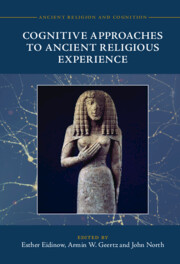Book contents
- Cognitive Approaches to Ancient Religious Experience
- Ancient Religion and Cognition
- Cognitive Approaches to Ancient Religious Experience
- Copyright page
- Contents
- Figures and Tables
- Contributors
- Abbreviations
- Funder Acknowledgement
- Introduction
- Part I Ritual
- Part II Representation
- Part III Gender
- Part IV Materiality
- Part V Texts
- Chapter 10 Bridging the Gap
- Chapter 11 A Relevant Mystery
- Index
- References
Chapter 10 - Bridging the Gap
From Textual Representations to the Experiential Level and Back
from Part V - Texts
Published online by Cambridge University Press: 28 July 2022
- Cognitive Approaches to Ancient Religious Experience
- Ancient Religion and Cognition
- Cognitive Approaches to Ancient Religious Experience
- Copyright page
- Contents
- Figures and Tables
- Contributors
- Abbreviations
- Funder Acknowledgement
- Introduction
- Part I Ritual
- Part II Representation
- Part III Gender
- Part IV Materiality
- Part V Texts
- Chapter 10 Bridging the Gap
- Chapter 11 A Relevant Mystery
- Index
- References
Summary
In the chapter, I explore what may be gained by reading textual instantiations of feelings in light of current knowledge of their underlying emotional counterparts. The overall idea is to bridge the gap between ‘biology’ and ‘culture’ to examine how knowledge about basic biology may contribute to deepen the textual understanding. I seek to illustrate the theoretical discussion by providing a biological emotional reading of Paul’s First Letter to the Corinthians chapter 6. I analyze Paul’s emphasis on baptism as moral cleansing in light of recent research in moral psychology and evolutionary biology on the Lady Macbeth complex. The argument is that there is an intrinsic relationship between the use of water and cognitive notions of cleanness, purity, dirt, moral filth, and impurity. These insights may be used to cast further light on Paul’s argument, thus illustrating the overall point that historians of religion, ancient historians, and classicists will benefit considerably by including knowledge from life sciences in the historical analyses.
- Type
- Chapter
- Information
- Cognitive Approaches to Ancient Religious Experience , pp. 245 - 265Publisher: Cambridge University PressPrint publication year: 2022

